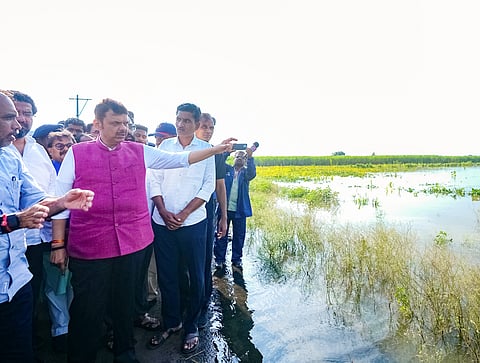

Drought-prone regions in Maharashtra have experienced a deluge during the southwest monsoon this year, with nearly seven million acres of agriculture land washed away between August and September, according to preliminary estimates by state officials.
Extreme weather-induced heavy rainfall damaged crops over 6.9 million acres of Maharashtra’s agriculture land, affecting thousands of farmers across 30 districts.
Precipitation in the past two months has surpassed annual average rainfall by 109 per cent. Maharashtra received nearly 1,000 millimetres of rainfall between June and September this monsoon.
Nanded, Beed, Solapur, Yavatmal and Buldhana are the worst affected districts, according to the state agriculture department. One hundred and fifty villages have been submerged, with floodwaters slowly receding.
Over 1.8 million acres of crops have been ravaged in Nanded district alone, according to figures from the agriculture department. Solapur, Yavatmal and Dharashiv (formerly Osmanabad) have recorded losses of 0.99 million acres, 0.85 million acres and 0.82 million acres respectively.
Eight districts including Nanded, Solapur, Yavatmal, Dharashiv, Beed, Ahilyanagar (formerly Ahmednagar), Washim, Buldhana, Jalna, Hingoli, Akola and Amravati have each reported crop losses for over 0.1 million acres, officials said.
These areas are traditionally rain shadow. Many farmers residing in these districts claimed they have not seen such rainfall in the past 50 years.
A drought-prone district like Nandurbar has received an additional 71.41 per cent of its average annual rainfall. Another district, Beed, received nearly 140 per cent more than its average annual rainfall.
Farmers took to social media to show the damage. They posted photographs and videos of farmlands swept away by the deluge, groundwater wells filled up to the brim and rivers overflowing with silt.
Deepak Gundekar, a farmer from Beed district, said his agricultural land of 10 acres has been irreparably damaged by the floods. “The top soil used for cultivation has been swept away. How will I prepare for the Rabi season? Farmers’ entire livelihoods have been submerged in the floodwaters and silt,” he said.
Kharif crops including soybean, maize, cotton, urad, tur (pigeon pea) and moong have been heavily damaged.
Jagdish Davale, a 40-year-old farmer from Adgaon Budruk village in Chhatrapati Sambhajinagar (formerly Aurangabad) district had sown cotton, tur and maize on his 12 acres of agriculture land.
“I had planned to sell 50 per cent of it to earn about Rs 2 lakh from cotton for the Diwali festival next month and sell the remaining at the end of the year. But all has been submerged in the heavy rains between September 19 and 22,” he told Down To Earth (DTE).
In September alone, losses were reported on 3.085 million acres in the state. “Beed district has suffered damage on around 0.594 million acres, followed by 0.421 million acres in Ahilyanagar,” the official said.
Anupam Kashyapi, former Head (Scientist G) of the Weather Forecasting Division at India Meteorological Department (Pune), explained why the weather turned extreme.
High daytime temperatures over the past 15 days were about 2-3 degrees Celsius higher than average normal temperatures. These, along with high moisture levels, contributed to the formation of cumulonimbus clouds. The clouds caused heavy rains in a short time.
“The monsoon activity was not strong, but the meteorological conditions led to heavy rains,” he said.
Kashyapi said Maharashtra will have to brace for more rains owing to a low-pressure area in the Bay of Bengal. This will likely change to a deep depression, influencing westerlies in the Arabian Sea.
“The combined effect will lead to rainfall movement from South Odisha towards south Chhattisgarh, followed by the Vidarbha, Marathwada and Konkan regions of Maharashtra. The conditions have already started forming,” he told DTE.
The state agriculture department will further assess the situation in the coming weeks to estimate the complete extent of the damage.